I have been meaning to post a recipe for Polish Easter Babka for several years now, and while Easter has already passed us by this year, I am determined to post the recipe! The delay has been due to an odd reason, and that is that I haven’t been able to figure out a recipe that does not make more than one large Babka. For the past two years I’ve made one Bundt Babka and then 4 or so mini Babkas for the Easter food basket that we put together to be blessed on Holy Saturday. And for several years before that, I made the equivalent of three large Babkas at once. No, it’s not all eaten at once. Instead, I do my usual thing of freezing a lot for later. While I am the butt of family jokes for my reflexive habit of freezing leftovers, all the kidding around stops when I am able to serve up a special treat during the hot summer months by just reaching into the freezer and pulling out some Babka.
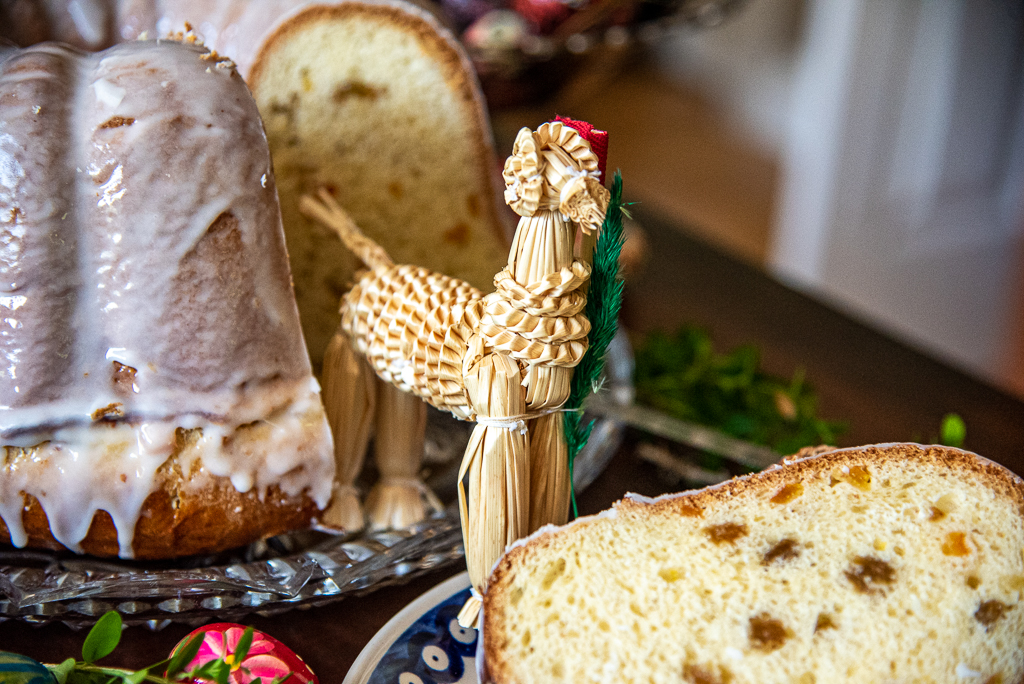
“Babka” comes from the word for grandmother. It is not only an Easter cake in Poland, but also in the Ukraine, Russia (kulich), and Belarus–at least. Babka is also found in Jewish culture. Azhkanazy Jews in New York City introduced the chocolate babka–which I have yet to try, but am putting it on my list of “must do” recipes.
Below is my recipe for Polish Easter Babka. It makes one big Babka, but the recipe includes a Note with increased proportions in case you need to make both one big Babka and a few mini Babkas on the side. There are many recipes for Polish Babka, all with different proportions. The proper texture (crumb) is light, airy, and a little dry, but not stretchy. If the texture turns out to be more like a doughnut, then something didn’t turn out right, either in your method or the proportion of wet to dry ingredients. The Babka no doubt will still be tasty, so don’t fret over it.
Following the recipe is step-by-step illustrated instructions. Hope to see you after the recipe!

| Servings |
large Bundt cake
|
- 4 1/2 teaspoons active dry yeast, not rapid rise (2 packets = 14 grams = 50 grams fresh yeast)
- 1 teaspoon granulated sugar
- 1/3 cup milk, lukewarm
- 1/3 cup all-purpose flour
- 5 large or XL egg yolks
- 3/4 cup granulated sugar
- 1 teaspoon vanilla extract
- 1/4 teaspoon almond extract
- zest of 1 lemon
- zest of 1 orange (optional) (omit if candied orange peel is being used)
- 2/3 cup milk, lukewarm
- 4 cups all-purpose flour (up to 1/2 cup flour extra may be necessary in case dough is sticky)
- 8 tablespoons unsalted butter, very soft (i.e., 1 American stick or 113 grams)
- 1 cup golden or regular raisins (optional - macerate in 1 tablespoon rum; drain and dredge in 1 T flour before using)
- 1/2 cup candied orange peel (optional)
- 1 large egg for brushing egg wash just before baking
- 1 1/4 cups powdered sugar (add more if too runny)
- 2 to 3 tablespoons freshly squeezed lemon or orange juice (juice of one lemon or 1/2 orange) (add more if too thick)
- 1 tablespoon corn syrup (optional but recommended)
- unsalted butter for serving with slices of Babka
Ingredients
Starter Sponge
Dough
Glaze
|

|
- In a small bowl, combine yeast and sugar. Add lukewarm milk and stir until some of the yeast dissolves. Stir in 1/3 cup flour. The consistency should be that of thin sour cream. Cover loosely with a kitchen towel and let rise in warm place until light and spongy, about 15-20 minutes.
- Grease and flour 12-cup Bundt pan (i.e. 10-inch diameter pan). Set aside.
- In a large bowl, beat with an electric mixer (paddle attachment) egg yolks and sugar on medium high speed until light and whitish. Add vanilla and almond extracts, lemon zest, and orange zest (if using). Omit orange zest if later adding candied orange peel. [Note, orange zest can be completely omitted, but do not omit lemon zest.] Beat egg mixture on medium high for one minute.
- Add sponge to egg mixture and begin mixing on low speed. With the motor running, add 3 1/4 cups of the flour, alternating with milk in three additions. Change to dough hook. On low speed, gradually mix in 3/4 cup more of flour until fully incorporated and dough forms a ball around the dough hook, about 3 minutes. Dough should be slightly sticky to the touch but also should be springy and easily peel off fingers. [Note: If dough does not form a ball around dough hook or is still too sticky, mix in a little more flour, 1-2 tablespoons at a time, up to 1/2 cup flour. Mix thoroughly between each addition. Mix for 3 minutes more after all of extra flour is incorporated.] **For next step, you can continue using mixer for mixing in both butter and raisins/orange peel. Alternatively, you can decide to incorporate either butter or raisins/orange peel or both by kneading in by hand. If you choose to knead by hand, turn dough out onto lightly floured countertop or board.
- In three additions, incorporate soft/melted butter into dough either by kneading by hand or using mixer (set on low speed). After butter is fully incorporated, knead or mix for about 5 minutes more or until smooth, shiny, and elastic. Knead or mix in raisins and candied orange peel (if using) until fully incorporated, about 5 to 10 minutes. [If you used a mixer up to this point, I suggest you knead the dough for a few minutes by hand on a countertop or board after the raisins and orange peel have been mixed in.]
- Roll dough (with hands) into a thick log, about 16-17 inches long. Bring ends together to form a circle and place into pan. Press dough so that dough touches sides and is at an even height all around. Dough should fill about 1/3 of pan. Cover with kitchen towel dusted with flour. Let rise in warm place until doubled in size, about 2 1/2 to 5 1/2 hours.* Wait for dough to rise until it forms a dome that is slightly above rim of pan.
- Preheat oven to 350°F/180°C (begin preheating about 10 minutes prior to full rise of dough). Rack should be placed one rung below middle.
- When dough has fully risen and is ready to be placed in oven to bake, beat one egg with a fork and brush on top of dough with pastry brush. Bake in preheated oven for 30-35 minutes, or until a bamboo skewer or cake tester comes out clean. Remove from oven. Cool in pan for 10-15 minutes. Loosen sides and center with knife and turn onto rack. Let cool completely to room temperature before glazing.
- In a small bowl or 2 cup measuring cup, vigorously mix powdered sugar and lemon or orange juice (alternative is to use warm water and add a few drops of almond extract). Mix in corn syrup if using (corn syrup adds shine to glaze after glaze dries). Adjust thickness by adding more confectioners sugar or lemon juice to achieve correct consistency. [To check consistency: Lift spoon or fork and let glaze drip back into bowl. Ribbon of glaze should remain on surface a few seconds before disappearing.]
- Brush glaze all over top and sides of Babka with pastry brush. Let sit at room temperature until dry. Cut into slices and serve. Best if served the next day. Offer unsalted butter on the side for spreading on slices.
* If the rise of the dough has a slow start and does not seem to rise at all for a couple of hours, this may be normal. Speed of rising depends on many variables. Be patient and let the dough fully rise (doming just over the rim of the pan) before baking.
** Instead of glaze, Babka may be dusted with powdered sugar.
*** If a larger batch is needed to make extra mini Babkas (3-4) for the Easter basket that will be blessed, use the following proportions. Starter ingredients: 3/4 cup milk, 6 tsp active dry yeast, 1 teaspoon sugar, 3/4 cup flour. The rest of the ingredients: 7 egg yolks, 1 cup sugar, 1 1/2 teaspoons vanilla extract, generous 1/4 teaspoon almond extract, zest of one lemon, zest of one orange (unless using candied orange peel), 1/2 cup lukewarm milk, 4 1/3 to 4 1/2 cups flour, 11 tablespoons softened butter, 1 1/4 cup raisins + 1/2 cup candied orange peel, 1 egg for egg wash. Method for making dough is the same, except prepare extra pan for 3-4 mini Bundts or small loaf pan (grease and dust with flour). Glaze ingredients: 1 1/2 cups powdered sugar, 3-4 Tbsp lemon juice (about 1 lemon) or orange juice, 1 tablespoon corn syrup.
STEP-BY-STEP ILLUSTRATED INSTRUCTIONS
For the photos taken below, I opted to make a bigger batch of Babka so that I’d have a large Babka and then mini-Babkas too. Keep this in mind when looking through the photos–it may explain some odd measuring cups.
Make the sponge first (though you can grease and flour the pan first if you want!). The starter needs to rise in a warmish place, which for me is usually the oven with the light on. Or, I turn on the oven to “warm” for about 3 minutes and then turn the oven off. If the oven is too hot, I keep the door open until it cools down a bit.
Back to the sponge: In a small bowl, combine the yeast (2 packets of active dry yeast–not rapid rise or instant yeast) and 1 teaspoon sugar.

Add slightly warmed milk to the bowl and stir with a spoon until some of the yeast (partially) dissolves.

Stir in the flour. The consistency should be like thin sour cream.

If the consistency for you is a little thinner (which is what happened to me yesterday when I baked another Babka), that’s OK. Thin sour cream consistency will work too. If you are worried about it, though, add 1 T of flour to the mix.

Cover the bowl loosely with a kitchen towel and let the starter rise in an unheated oven with the light turned on, or other warm place, until light and spongy, about 15-20 minutes. Meanwhile, grease and flour the Bundt pan (and any mini Bundts if you are making a bigger batch!). If you want to be super traditional, instead of flouring the pan, dust with fine breadcrumbs. Then mix together the egg yolks and sugar. In the photo below, quite a bit of egg white creeped in. Don’t worry if that happens! Your Babka will still turn out just fine. You might need to knead in more flour because of the extra liquid. A few times in the past, I forgot to separate the whites from the yolks and made whole egg Babkas. Boy were they big! But they were still tasty so don’t fret if you make that mistake. The Babka will be lighter in color on the inside and the crumb will be a little different (more dough-y), but it will still be tasty and impressive.

Mix the eggs and sugar on medium high until whitish in color.

Mix in the vanilla and almond extracts and lemon and orange zests. [There is no need to add orange zest if adding in candied orange peel later. In fact, orange zest may be omitted altogether if you don’t have any oranges, but better not omit the lemon zest.] Remember to scrape the bowl at least once. Check also to see if the zest is stuck to the paddle. If so, scrape the zest off the paddle and return it to the bowl.

Now you are ready to add in the starter/sponge, which should have risen as seen in the photo below after 15-20 minutes. Stop the mixer while you spoon the sponge into the bowl.

Mix sponge in on low speed and then immediately start adding flour.

Keeping the mixer on low speed, gradually spoon in 3 1/4 cups of flour while the motor is running.

Alternate with milk. I usually estimate adding in the warm milk in 3 additions. By the way, I warm the milk in a pot on the stove. It’s a little tricky because it’s easy to overheat the milk. The milk should be just slightly warmer to the touch than room temperature.


At this point, you should change to the dough hook.

Add in some more flour, about 3/4 cup (if making the original, 1-Babka recipe). The dough should start to form a ball around the dough hook and be much less sticky.
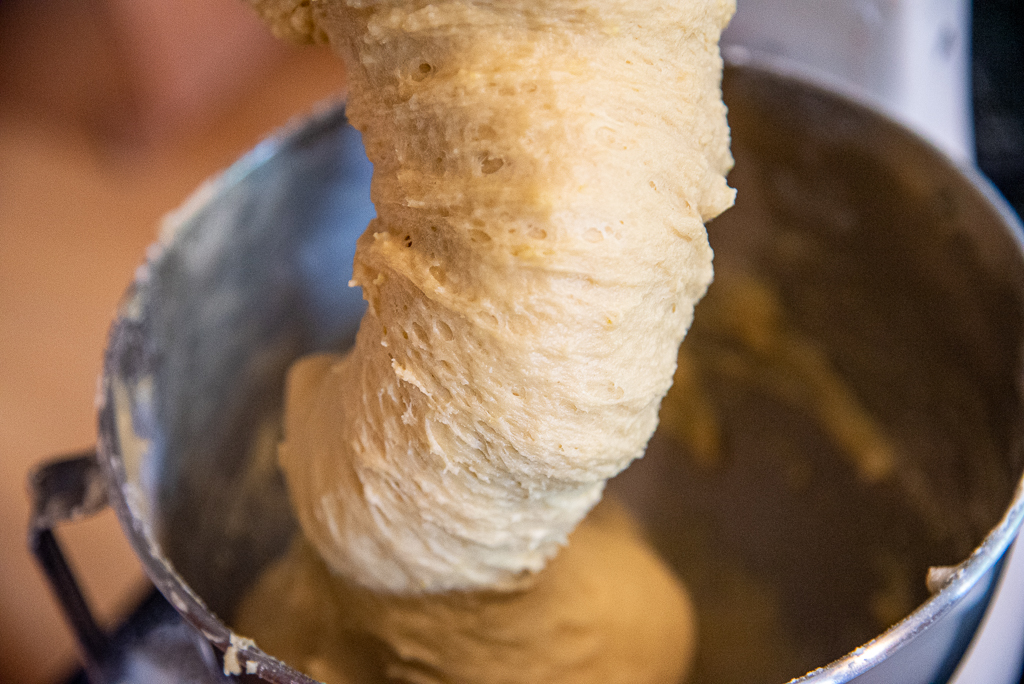
You can move on to the next step if the dough comes away from the bowl as the dough hook spins around. IF you find the dough is too sticky and isn’t springy at all, gradually add in 1-2 tablespoons of extra flour, mixing well to fully incorporate. Check the dough. If it’s still too sticky and doesn’t come off the walls of the bowl while mixing, add in another 1-2 tablespoons. Repeat up to 2-3 times until the dough is tacky to the touch and springy. You shouldn’t add in more than 1/2 extra flour or the dough will be too hard and the end result once the Babka is baked will be a dense and hard cake (though still edible!).

At this point, you can choose to turn out the dough onto a countertop or board to knead in the rest of the ingredients (butter, raisins and orange peel) or continue to use the mixer. For this batch, I chose to use my mixer, but in all honesty, I prefer to knead in the rest by hand because then I have a better feel for the dough (and because my old mixer’s motor is at risk of burning out after all of that mixing!). Either knead in or mix in the super soft butter–do so gradually. In this photo, I wanted to show you the butter in the bowl, but it was a tad too much in the bowl at once because when I turned on the mixer again, the butter splattered all over the counter and the floor. So take this advice: gradually add the butter into the bowl, mixing to incorporate before adding more to avoid splatter! If you are kneading by hand, you should also incorporate the butter in a few additions because it’s difficult to incorporate the butter all at once.

Knead by hand or use mixer set at low speed to incorporate the raisins and any candied orange peel you want to add in. Candied orange peel adds a lot of flavor and texture to the Babka, but it’s OK if you don’t have any. [If you are interested in making your own candied orange peel, here is a link to my favorite candied orange peel recipe posted on HollyTrail.] By the way, I used regular raisins for this batch, but it’s best to use golden raisins, which will match the golden flair of the fully baked Babka. I sometimes soak the raisins in rum before using. If I do that, I then drain the rum and toss the raisins in some flour before adding to the dough so they don’t sink to the bottom while baking. It’s not a tragedy if you skip this step. The raisins may still stay put and not sink to the bottom, but you may need to knead in slightly more flour in the final stages of dough preparation.
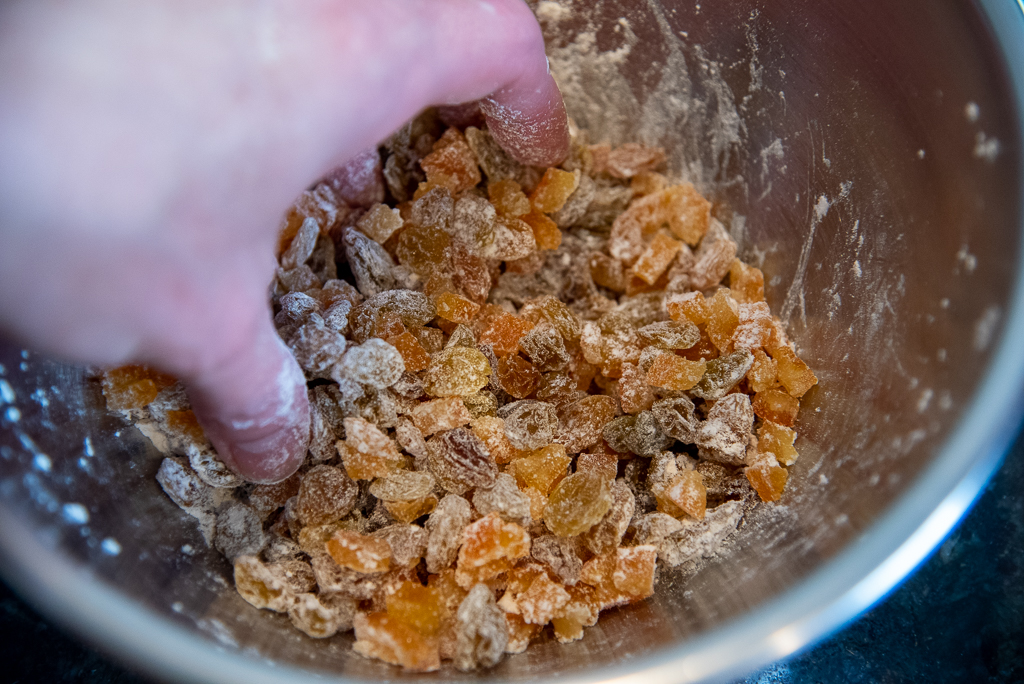
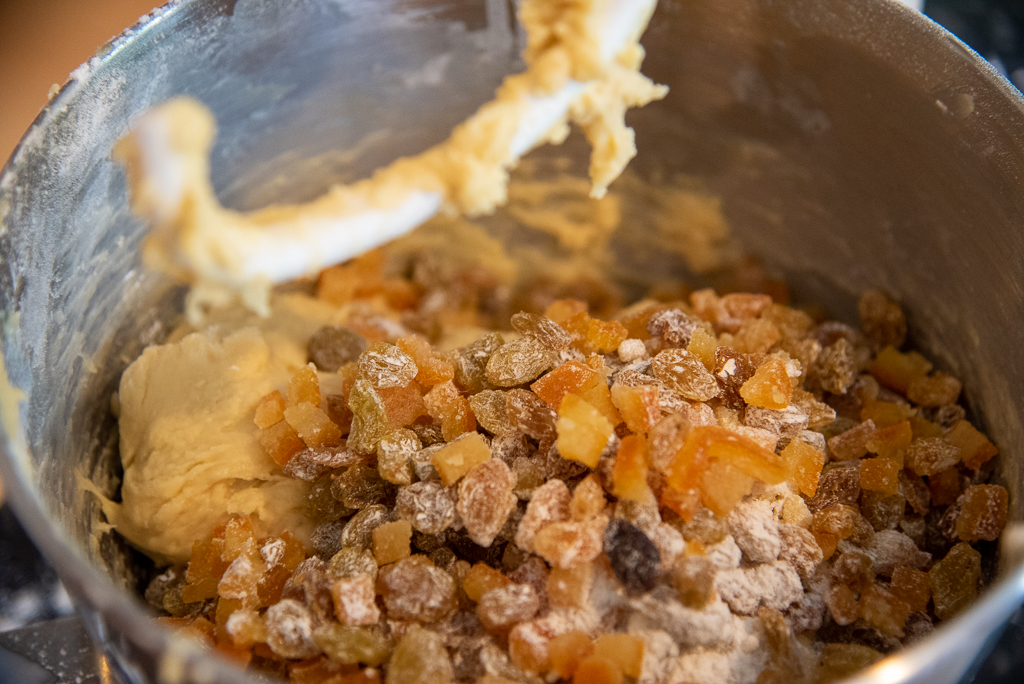
Even if you chose to use a mixer to incorporate the butter and inclusions, I suggest doing the last bit of kneading on a countertop or board. At this stage, there should be no need to lightly flour the surface unless your dough is still too sticky. Knead for about 5-10 minutes. If you think the dough is too sticky, add in some flour, 1 tablespoon at a time, but it should usually not need to be more than 1/4 cup. Really knead in that extra flour before deciding whether to add in more flour. I find that this is the trickiest part of making Babka–deciding when there is enough flour in the dough so that the dough is soft enough, yet not sticky. If you rush this step and think that adding in a bunch of flour all at once will get you to the finish line faster, resist the temptation. If you add in too much flour, your dough may not be sticky, but it may end up being too hard. The resulting Babka when baked will be like a brick–assuming it rises. So–be careful and don’t add too much flour to the dough.

Knead so that the dough is shiny, smooth, elastic, and does not stick to your fingers. The dough below is almost done. I needed to knead this batch about 10 minutes.

Roll the dough with your hands so that it forms a 16-17 inch rope.

Then form a circle and place it in the pan. Pat the dough so that it covers the bottom, reaches the sides of the pan, and is even all around.

As I mentioned earlier, I made a larger batch of dough. Below are photos of what I used the extra dough for–which was to make a few mini-Babkas.

Cover the pan with cloth, usually dusted with flour so that the risen dough doesn’t stick to the cloth, and let the dough rise in a warm, draft-free location (like your oven with the light turned on).

Let the dough rise until “doubled in bulk.” In my case, it took 5 hours for this to happen. The range of time is usually 3-5 hours. That brings us to the second tricky part of yeasted cakes – judging when the dough has risen sufficiently. Check each hour to see how fast the dough is rising. It usually has a slow start and then you’ll see it pick up for lost time! Between 10-15 minutes before you judge the dough to be ready, preheat the oven. Keep in mind that if you let the dough rise too much, you risk the dough being over-proofed. The Babka may then collapse in the oven–that’s not a good thing. With this recipe, the dough should be ready when it domes just above the rim of the pan. If the dome or your risen dough is slightly smaller than what you see in the photo below, it still may be ready to go. I was pushing the limits with this batch! Check dough readiness by lightly pressing into the dough with your finger. If the indentation doesn’t easily bounce back yet the dough feels light, then it should be ready to bake. If you see that it has risen and then it is starting to collapse or forms a “crust,” you are too late. [Go ahead and bake the cake anyway. The resulting Babka may not be perfect, but it’s still worth finishing.]

When ready to bake, fork whip a whole egg in a small bowl and brush the top with the beaten egg. This will give it a nice shin and color when fully baked.


The Babka should be fully baked in about 30-35 minutes. To check doneness, insert a long bamboo skewer into the center of the Babka (to the bottom). If the skewer comes out clean, the Babka is ready to be removed from the oven. For mini-Babkas, they should be ready in 15 minutes.

When cooled about 10-15 minutes on a wire rack, loosen the sides and center with a sharp knife and turn out onto the counter or wire rack. Cool completely on a rack before moving on to the next step.

The next step is either to dust with confectioners sugar, slice and serve, or glaze the cake. To make the glaze, combine the confectioners sugar with 2 tablespoons of lemon or orange juice (or warm water). I also mix in 1 tablespoon of corn syrup, which makes the glaze slightly shiny when set. Otherwise, the glaze may turn out dry and crumbly.

Brush on the glaze and let the glaze dry on the cake at room temperature.

Here my daughter is glazing a mini-Bundt.

All the Babkas have been glazed–the end is near!

After about 1/2 an hour to an hour, the glaze should be set. Below is the finished Babka. The glaze is dry and the Babka is ready to be served. The boxwood that I added for the photo is traditional greenery used to decorate the Polish Easter food basket for blessing on Holy Saturday.

We like to cut into the Babka on the next day after baking. It tastes great fresh, but a little “yeasty” and may be more difficult to slice into. If the Babka is prepared correctly, the slices should be clean and not too crumbly or stretchy.
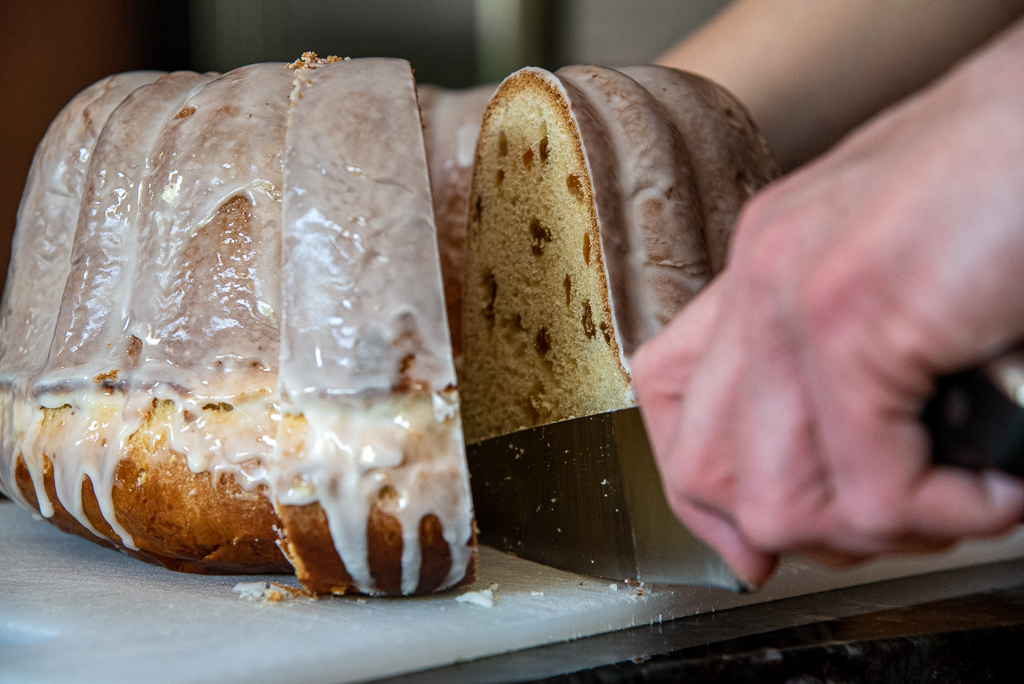

And there you have it – Polish Easter Babka!

With similar sweet, yeasted dough, I also like to make braided bread for Easter. That’s for another post. . . .
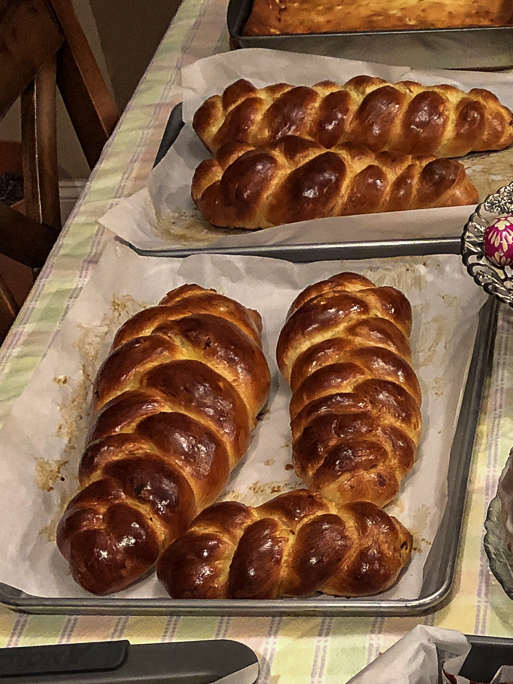




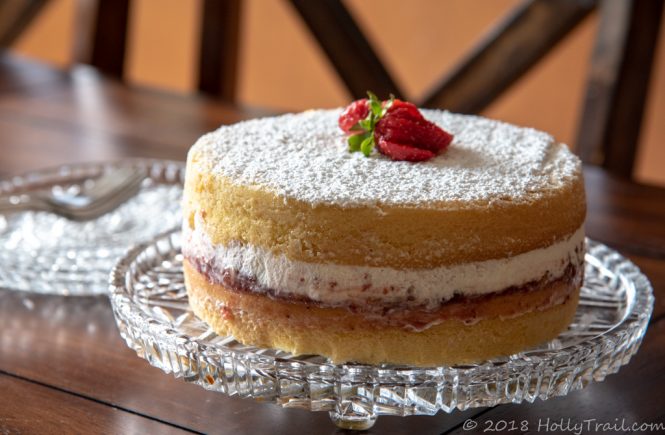
2 Comments
Thank you for sharing this recipe. It was wonderful! The photos were SUPER helpful! I found I had to add much more flour because I has added 8 large sized yolks vs xl size as the recipe mentions. My husband enjoyed it too.
I am glad it worked out and thanks for your feedback, especially about the added flour. I find making babka tricky that way no matter how many times I’ve made it!